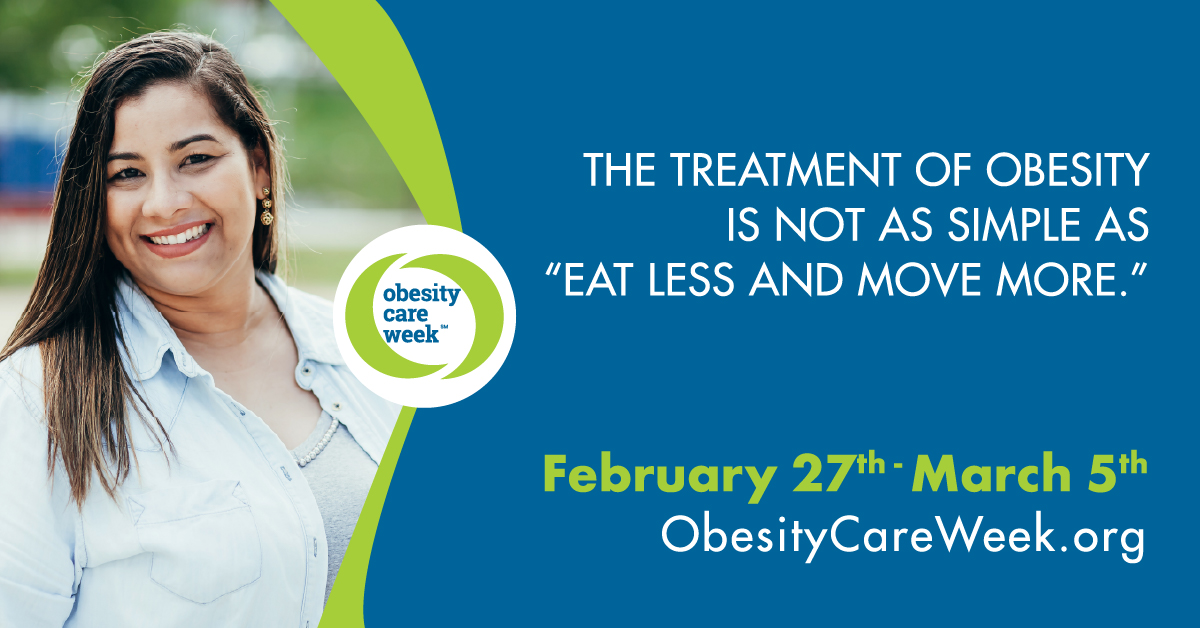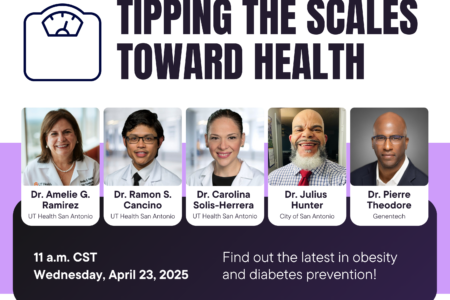
Share On Social!
Obesity Care Week 2022 (#OCW2022) is here!
From Feb. 27 to March 5, 2022, Obesity Care Week is an annual public awareness effort to end weight bias, as well as raise awareness, educate and advocate for a better world for people living with obesity. Also, World Obesity Day is March 4, 2022.
Our Salud America! Latino health equity team at UT Health San Antonio is happy to serve as an OCW2022 Champion to support this awareness week.
“Unlike most other diseases, obesity is one that continues to be stigmatized and those impacted struggle to receive any care in many cases, let alone adequate care,” said Dr. Amelie G. Ramirez, director of Salud America! at UT Health San Antonio and a leading health disparities researcher. It’s time to change the way we care for obesity, and OCW2022 provides us the opportunity to demand change.”
Salud America! research has found that U.S. Latinos face health inequities in many areas—from poverty and social support to access to affordable housing and transit—that contribute to higher rates of obesity.
 Latino adults have higher obesity rates than their white peers (47% and 37.9%), as do Latino children (20.7% and 11.7%). This, in turn, leads to disparities in diabetes and risk for COVID-19 and other health conditions. Addressing the root causes, such as reducing poverty and improving access to healthy food, can help address obesity.
Latino adults have higher obesity rates than their white peers (47% and 37.9%), as do Latino children (20.7% and 11.7%). This, in turn, leads to disparities in diabetes and risk for COVID-19 and other health conditions. Addressing the root causes, such as reducing poverty and improving access to healthy food, can help address obesity.
Obesity Care Week has five goals:
1. Recognition. Obesity was officially recognized as a disease by the American Medical Association in 2013. Yet misperceptions – not science – continue to shape how people with obesity are treated both medically and generally within society. Now is the time to act by listening to science and ending the stigma.
2. Weight Bias. Did you know that only one U.S. state makes it illegal to discriminate based on weight? Instances of bias are those daily large and small instances of discrimination that negatively impacts both health and quality of life for people with obesity. Now is the time to act by stopping weight bias.
3. Access to Care. Most diseases and illnesses have numerous options for treatment, yet obesity care remains piecemeal and fractured, and is often dependent on your zip code or employer’s health plan. Now is the time to act by breaking down the barriers to obesity care.
4. Science-Based Treatments. We have all seen the ads for snake oil treatments boasting that you will lose 50 pounds in a month. Successful obesity and weight management requires a combination of science-based treatment options and comprehensive continuums of care. Now is the time to act by demanding robust, science-based health support systems and treatments.
 5. Prevention. “Eat less and move more” is not the magic treatment or cure for obesity. As a society, we must continue to grow our understanding of obesity to develop and make accessible science-based prevention programs that are proven to measurably improve health. Now is the time to act by demanding expanded, proven, and widely accessible prevention programs.
5. Prevention. “Eat less and move more” is not the magic treatment or cure for obesity. As a society, we must continue to grow our understanding of obesity to develop and make accessible science-based prevention programs that are proven to measurably improve health. Now is the time to act by demanding expanded, proven, and widely accessible prevention programs.
“Please join us in supporting this annual awareness week to help change the way we care about obesity, especially for Latinos and other communities of color,” Ramirez said.
Obesity Care Week is led by Obesity Action Coalition, The Obesity Society, the STOP Obesity Alliance, the Obesity Medicine Association, and the American Society for Metabolic and Bariatric Surgery.
The Obesity Action Coalition also has launched Stop Weight Bias, a national campaign to end weight bias and push equality forward. Sadly, surveys show that 90% of people felt that weight bias exists in today’s society, and 41.7% had experienced stigma because of their weight.
The campaign also has great PSAs and infographics and fact sheets on this topic.
Sign-up for OCW Alerts or visit ObesityCareWeek.org. Use #OCW2022 on social media.
Editor’s Note: Image credit to the Obesity Action Coalition.
By The Numbers
1
Supermarket
for every Latino neighborhood, compared to 3 for every non-Latino neighborhood



